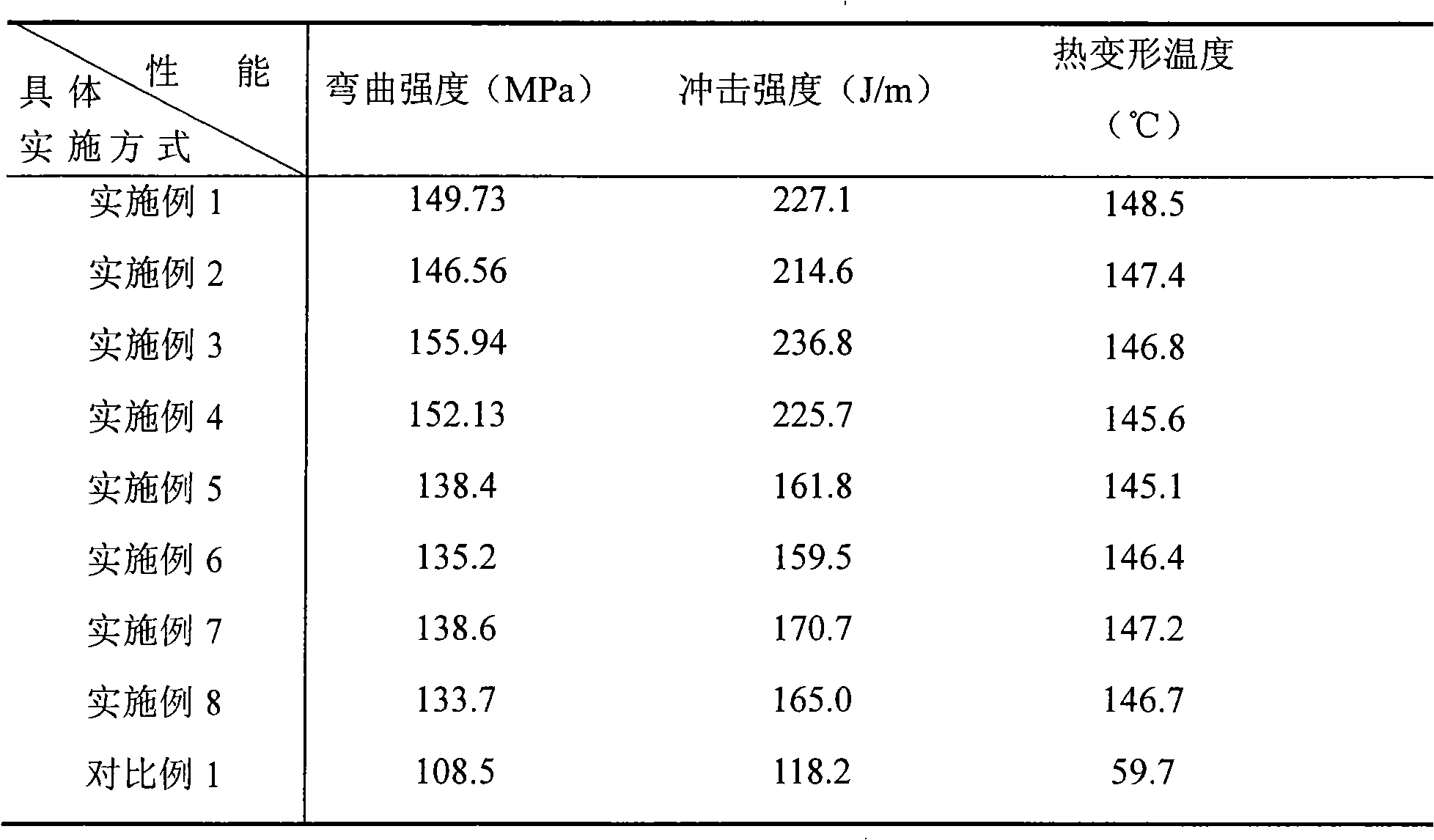High strength and high heat resistance polylactic acid composite material and preparation method thereof
A composite material, polylactic acid technology, applied in high-performance polylactic acid composite materials, high strength and high heat resistance and its preparation field, can solve the problem of limiting the large-scale application of polylactic acid, the small contribution of polylactic acid heat resistance, polylactic acid materials Deformation and other problems, to achieve the effect of low impact strength, low equipment requirements, and improve impact resistance
- Summary
- Abstract
- Description
- Claims
- Application Information
AI Technical Summary
Problems solved by technology
Method used
Image
Examples
Embodiment 1
[0047] Glass fiber modification process: by weight, take 15 parts of glass fiber, 75 parts of toluene, and 1 part of γ-glycidyl etheroxypropyl trimethoxysilane coupling agent, and carry out batching, under the protection of nitrogen, at 70 ° C Stirring and mixing at low temperature, and then reflux for 3 hours; after suction filtration and washing, dry at 100°C to obtain modified glass fibers.
[0048] Talc powder modification process: by weight, take 15 parts of talc powder, 75 parts of toluene, and 1 part of γ-glycidyl etheroxypropyl trimethoxysilane coupling agent, and carry out batching, under the protection of nitrogen, at 70 ° C Stirring and mixing at low temperature, and then reflux for 3 hours; after suction filtration and washing, dry at 100°C to obtain modified talc powder.
[0049] The semi-crystalline poly-L-lactic acid was vacuum-dried at 40°C for 6 hours; the modified glass fiber and modified talcum powder were vacuum-dried at 120°C for 6 hours. Get 40 parts of ...
Embodiment 2
[0051] Glass fiber modification process: by weight, take 15 parts of glass fiber, 75 parts of toluene, and 1 part of γ-glycidyl etheroxypropyl trimethoxysilane coupling agent, and carry out batching, under the protection of nitrogen, at 70 ° C Stirring and mixing at low temperature, and then reflux for 3 hours; after suction filtration and washing, dry at 100°C to obtain modified glass fibers.
[0052] Barite modification process: by weight, take 15 parts of barite, 75 parts of toluene, and 1 part of γ-glycidyl etheroxypropyl trimethoxysilane coupling agent, and carry out batching, under the protection of nitrogen, in Stir and mix at 70°C, and then reflux for 3 hours; after suction filtration and washing, dry at 100°C to obtain modified barite.
[0053] The semi-crystalline poly-L-lactic acid is vacuum-dried at 40°C for 6-12 hours; the modified glass fiber and modified barite are vacuum-dried at 120°C for 6 hours. Take 40 parts of poly L-lactic acid, 3 parts of modified barit...
Embodiment 3
[0055] Quartz glass fiber modification process: by weight, take 15 parts of quartz glass fiber, 75 parts of toluene, and 1 part of γ-glycidyl etheroxypropyl trimethoxysilane coupling agent, and carry out batching, under the protection of nitrogen, in Stir and mix at 70°C, and then reflux for 3 hours; after suction filtration and washing, dry at 100°C to obtain modified quartz glass fibers.
[0056] Talc powder modification process: by weight, take 15 parts of talc powder, 75 parts of toluene, and 1 part of γ-glycidyl etheroxypropyl trimethoxysilane coupling agent, and carry out batching, under the protection of nitrogen, at 70 ° C Stirring and mixing at low temperature, and then reflux for 3 hours; after suction filtration and washing, dry at 100°C to obtain modified talc powder.
[0057] The semi-crystalline poly-L-lactic acid was vacuum-dried at 40°C for 6 hours; the modified quartz glass fiber and modified talc powder were vacuum-dried at 120°C for 6 hours. Get 40 parts of...
PUM
 Login to View More
Login to View More Abstract
Description
Claims
Application Information
 Login to View More
Login to View More - R&D
- Intellectual Property
- Life Sciences
- Materials
- Tech Scout
- Unparalleled Data Quality
- Higher Quality Content
- 60% Fewer Hallucinations
Browse by: Latest US Patents, China's latest patents, Technical Efficacy Thesaurus, Application Domain, Technology Topic, Popular Technical Reports.
© 2025 PatSnap. All rights reserved.Legal|Privacy policy|Modern Slavery Act Transparency Statement|Sitemap|About US| Contact US: help@patsnap.com

